
Home - Search - Browse - Alphabetic Index: 0- 1- 2- 3- 4- 5- 6- 7- 8- 9
A- B- C- D- E- F- G- H- I- J- K- L- M- N- O- P- Q- R- S- T- U- V- W- X- Y- Z
RSA-3
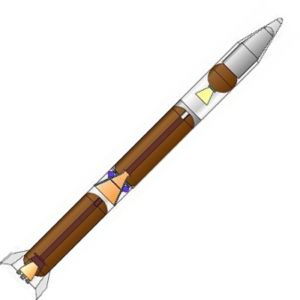 RSA-3 RSA-3 South African space launcher Credit: © Mark Wade |
Status: Retired 1990. First Launch: 1989-07-06. Last Launch: 1990-11-19. Number: 2 . Payload: 330 kg (720 lb). Thrust: 412.70 kN (92,779 lbf). Gross mass: 23,630 kg (52,090 lb). Height: 17.65 m (57.90 ft). Diameter: 1.30 m (4.20 ft). Apogee: 210 km (130 mi).
The RSA-3 was developed by the Houwteq organization at Grabouw, 30 km east of Cape Town. The Overberg Test Range near Bredasdorp, 200 km east of Cape Town, was used for test flights. The engine test facility was at Rooi Els. At the peak of development in 1992 50 - 70 companies in the public and private sector were involved, employing 1300 -1500 people.
As in the Shavit, the first and second stages used the same rocket motor loaded with 9 metric tons of propellant. The first stage used vanes in the exhaust for steering during the first 16 to 20 seconds of flight, after which the fins at the base of the vehicle provided aerodynamic control. The second stage had a higher expansion nozzle and may have been equipped with TVC for steering. Atop the second stage was a guidance - orientation - spin-up bus for the third stage and payload. Total mass of this bus and the payload shroud was 583 kg. After second stage burnout, the upper stage package entered a 148 second ballistic coast. A sideways trajectory deflection was made and the shroud was jettisoned. Then the third stage and payload were spun up, following by separation of the bus. The spin-stabilized third stage then made the 4,555 m-s burn to place the payload into orbit. The third stage was evidently similar to a 5 metric ton thrust spherical motor displayed by the Israelis for their Shavit launch vehicle.
The composite payload fairing for the RSA-3 was 4.5 m long, 1.3 m in diameter, and had a mass of 57 kg. The solar array for the satellite had a mass of less than 7 kg and with three panels could supply 295 W of power. The fairing could resist temperatures of up to + 100 degrees C during ascent and the thermal satellite blanket insulated the payload from temperatures ranging from -80 degrees C to + 100 degrees C.
As an ICBM, it is estimated that the three-stage version of the RSA-3 could have delivered a 340 kg warhead on Washington DC or a 400 kg warhead on Moscow. However such lightweight warheads were beyond declared South African technology. Therefore the RSA-3 was most likely purely a space launch adaptation of the RSA-2 IRBM, with the Peacekeeper-class RSA-4 fulfilling the ICBM role.
The RSA-3 and its mobile erector-launcher were in an advanced stage of test at the time the program was cancelled. It is not known what happened to the hardware that was built. Warheads of the size and type required for use on the RSA-3 were not in the inventory according to the declarations made by South Africa at the time of its nuclear disarmament and signature of the nuclear non-proliferation treaty. The RSA-4 was in the design stage.
The following is the detailed launch trajectory of the RSA-3:
| Event | Time from Launch -sec | Height -km | Slant Range - km | Vehicle Mass - kg | Velocity - m-s |
|---|---|---|---|---|---|
| Ignition | 0.0 | 0.0 | 0.0 | 23,564 | 0 |
| Separation Stages 1-2 | 54.9 | 12.8 | 8.4 | 13,349 | 575 |
| Separation Stages 2-3 | 140.0 | 104.3 | 179.8 | 2,961 | 3,225 |
| Bus maneuver and shroud ejection | 172.0 | 140.0 | 272.0 | 0 | 3,116 |
| Ignition of Apogee Kick Motor | 248.0 | 196.5 | 489.0 | 2,378 | 2,945 |
| Burnout of AKM | 342.0 | 210.0 | 914.0 | 0 | 7,498 |
| Separation of Payload | 460.0 | 212.0 | 1806.0 | 330 | 7,500 |
LEO Payload: 330 kg (720 lb) to a 210 km orbit at 41.00 degrees.
Stage Data - RSA-3
- Stage 1. 1 x RSA-3-1. Gross Mass: 10,215 kg (22,520 lb). Empty Mass: 1,100 kg (2,400 lb). Thrust (vac): 456.000 kN (102,512 lbf). Isp: 265 sec. Burn time: 52 sec. Isp(sl): 240 sec. Diameter: 1.30 m (4.20 ft). Span: 2.30 m (7.50 ft). Length: 6.30 m (20.60 ft). Propellants: Solid. No Engines: 1. Engine: RSA-3-1. Status: Out of Production. Comments: Source: Missile exhibit and placards, AF Museum, South Africa.
- Stage 2. 1 x RSA-3-2. Gross Mass: 10,971 kg (24,186 lb). Empty Mass: 1,771 kg (3,904 lb). Thrust (vac): 476.600 kN (107,144 lbf). Isp: 277 sec. Burn time: 52 sec. Isp(sl): 220 sec. Diameter: 1.30 m (4.20 ft). Span: 1.30 m (4.20 ft). Length: 6.40 m (20.90 ft). Propellants: Solid. No Engines: 1. Engine: RSA-3-2. Status: Out of production. Comments: Source: Missile exhibit and placards, AF Museum, South Africa. Empty mass includes 583 kg for payload shroud, guidance, orientation and spin-up platform that positions stage 3 and payload for final orbital insertion burn.
- Stage 3. 1 x RSA-3-3. Gross Mass: 2,048 kg (4,515 lb). Empty Mass: 170 kg (370 lb). Thrust (vac): 58.800 kN (13,219 lbf). Isp: 298 sec. Burn time: 94 sec. Diameter: 1.30 m (4.20 ft). Span: 1.30 m (4.20 ft). Length: 2.60 m (8.50 ft). Propellants: Solid. No Engines: 1. Engine: RSA-3-3. Status: Out of Production. Comments: Data accurate. Source: Missile exhibit and placards, AF Museum, South Africa. ARC/Rafael AUS 51 is identical.
Family: all-solid, orbital launch vehicle. Country: South Africa. Spacecraft: Greensat. Launch Sites: Overberg. Stages: RSA-3-1, RSA-3-2, RSA-3-3. Agency: IAI.
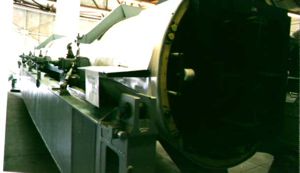 | RSA-3 Aft View Rear view of the RSA-3, showing the exhaust vanes and details of its erector-launcher. Credit: Steven McQuillan |
 | RSA-3 Cutaway Cutaway diagram of RSA-3 space launcher. This differs somewhat from the flight hardware now displayed in South African air museums. Credit: © Mark Wade |
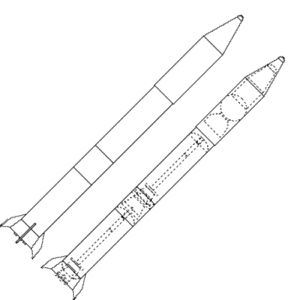 | RSA-3 Credit: © Mark Wade |
 | RSA-3 Aft View Aft view of the RSA-3 showing the jet vanes that provided first stage directional control. Credit: Steven McQuillan |
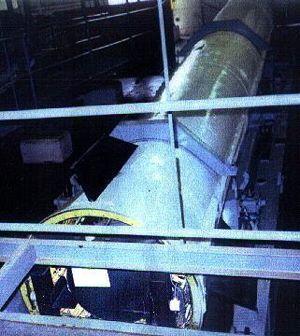 | RSA-3 Aft View Aft view of the RSA-3. Note the small first stage fins. |
 | RSA-3 Interstage Close-up of the RSA-3 interstage section. Credit: Steven McQuillan |
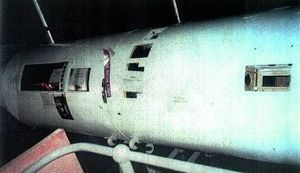 | RSA-3 Interstage View of RSA-3 forward interstage and payload sections. |
 | RSA-3 in Pretoria RSA-3 satellite launcher / long range missile at the A.F. Museum, Pretoria. |
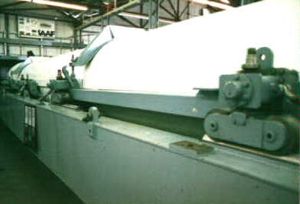 | RSA-3 TEL Detail of the RSA-3 transporter-erector-launcher. Credit: Steven McQuillan |
 | RSA-3 AKM Close-up showing the spherical Apogee Kick Motor third stage of the RSA-3. Credit: Steven McQuillan |
 | RSA-3 Forward View Forward view of the RSA-3 at the Air Force Museum, Pretoria. Credit: Steven McQuillan |
 | RSA-3 Forward View Forward section of the RSA-3; cut-outs reveal the Apogee Kick Motor third stage and the satellite within the payload shroud. Credit: Steven McQuillan |
 | RSA-3 Engine Test Technicians prepare RSA-3 stage in the test stand. |
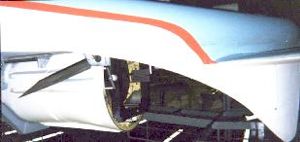 | RSA-3 - base detail RSA-3 - detail of rocket base, side view |
 | RSA-3 - stage detail RSA-3 - close-up of rocket in transporter |
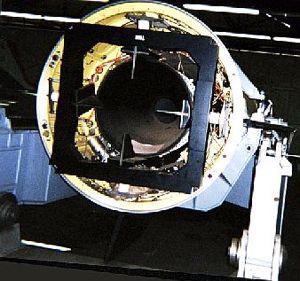 | RSA-3 - stage detail RSA-3 - detail of first stage base and rocket nozzle |
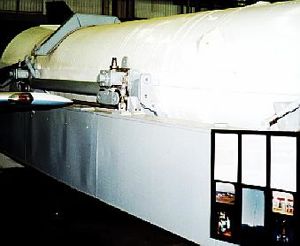 | RSA-3 - stage detail RSA-3 - close-up of rocket in transporter |
 | RSA-3 - base detail RSA-3 - detail of rocket base, side view |
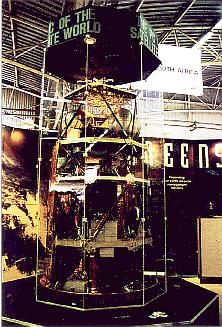 | RSA-3 - payload RSA-3 - satellite payload and kick stage |
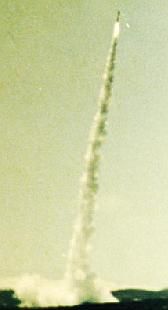 | RSA-3 - launch photo |
 | RSA-3 - nose detail RSA-3 - detail of nose cone |
 | RSA-1 , -2, -3, -4 |
1989 July 6 - . Launch Site: Overberg. LV Family: Jericho. Launch Vehicle: RSA-3.
- Test mission - . Nation: South Africa. Agency: Armsco. Apogee: 300 km (180 mi).
1990 November 19 - . Launch Site: Overberg. LV Family: Jericho. Launch Vehicle: RSA-3.
- Test mission - . Nation: South Africa. Agency: Armsco. Apogee: 300 km (180 mi).
Back to top of page
Home - Search - Browse - Alphabetic Index: 0- 1- 2- 3- 4- 5- 6- 7- 8- 9
A- B- C- D- E- F- G- H- I- J- K- L- M- N- O- P- Q- R- S- T- U- V- W- X- Y- Z
© 1997-2019 Mark Wade - Contact
© / Conditions for Use
